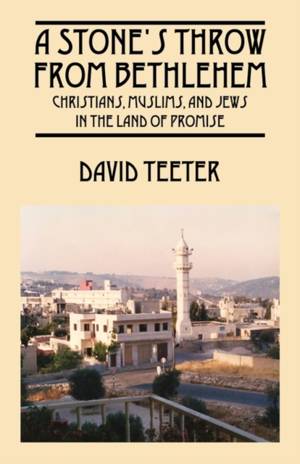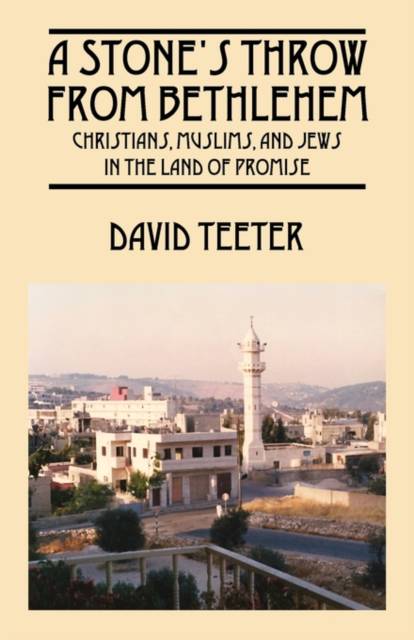
- Retrait gratuit dans votre magasin Club
- 7.000.000 titres dans notre catalogue
- Payer en toute sécurité
- Toujours un magasin près de chez vous
- Retrait gratuit dans votre magasin Club
- 7.000.000 titres dans notre catalogue
- Payer en toute sécurité
- Toujours un magasin près de chez vous
A Stone's Throw From Bethlehem
Christians, Muslims, and Jews in the Land of Promise
David Teeter
Livre broché | Anglais
20,45 €
+ 40 points
Description
This is the story of David and Willow Teeter's interfaith work with Christians, Muslims, and Jews in Israel and Palestine. David explores three intriguing ideas: 1. Can we be both "pro-Israel" and "pro-Palestine," and what does this mean?
2. Can Muslims be followers of Jesus while remaining Muslim, without converting to the Christian faith?
3. What are the prospects of peace? Can Israelis and Palestinians share the biblical "Land of Promise" in peace? This fast-paced story begins in a Jewish neighborhood in Jerusalem. It concludes in a safe house for Muslim students in Bethlehem. David and Willow moved to Israel in November of 1978. They lived for their first year in a Jewish neighborhood in Jerusalem. They made friends with their Jewish neighbors, while working with Christian Arab educators and pastors. David began a doctoral research project on Jewish-Christian-Muslim relations. He studied Judaism and Islam under Jewish and Muslim teachers. To further this research, David and Willow moved to the Palestinian village of Beit Jala, just a "stone's throw from Bethlehem." David taught at Bethlehem Bible College. Willow taught English at Bethlehem University. She began inviting her Muslim students to our apartment in Beit Jala. Students began bringing other students. This soon evolved into an off-campus Friendship Center in Bethlehem. Willow's Muslim students were curious about Christmas. Willow and David put on a feast for their Muslim friends. This became an annual event. It gave them many golden opportunities to talk about Jesus with their Muslim friends. David and Willow learned from their Muslim friends. Their Muslim friends learned from them. Their Muslim friends invited them to visit their families in the rural villages and refugee camps throughout the West Bank and Gaza Strip. The Palestinian Intifada (uprising) broke out in 1987. Living across the street from a refugee camp, the Teeter's were caught in the middle. These were times of extreme stress and danger, with moments of sheer terror. Friendship Center became a safe house where Muslim students could escape the violence raging all around them. The Israeli military and the PLO were both aware of the Friendship Center, but chose not to interfere. After a series of narrow escapes, David and his team left Bethlehem, in November of 1989. In Parts 2 and 3 of this book, David shares in the insights he has gained from these 11 momentous years in Israel and Palestine. Part 2 of this book explores the idea of Muslim followers of Jesus. David describes what it means to be a Muslim, what Muslims know about Jesus, and the difficult issues between Islam and Christianity. Part 3 discusses the obstacles and the prospects for peace between Israel and Palestine. He makes a biblical case for two peoples sharing the "Land of Promise." David tells the story from a pro-Israel, pro-Palestine perspective. He has lived and worked with people on both sides of the conflict. He recognizes that both sides have plenty of scars and bleeding wounds from their decades of bitter conflict. His Christian faith tells him that God has room in his heart for Israelis and Palestinians, Christians, Muslim, and Jews. Peace is not only possible; it is God's intention for the people of this troubled land.
2. Can Muslims be followers of Jesus while remaining Muslim, without converting to the Christian faith?
3. What are the prospects of peace? Can Israelis and Palestinians share the biblical "Land of Promise" in peace? This fast-paced story begins in a Jewish neighborhood in Jerusalem. It concludes in a safe house for Muslim students in Bethlehem. David and Willow moved to Israel in November of 1978. They lived for their first year in a Jewish neighborhood in Jerusalem. They made friends with their Jewish neighbors, while working with Christian Arab educators and pastors. David began a doctoral research project on Jewish-Christian-Muslim relations. He studied Judaism and Islam under Jewish and Muslim teachers. To further this research, David and Willow moved to the Palestinian village of Beit Jala, just a "stone's throw from Bethlehem." David taught at Bethlehem Bible College. Willow taught English at Bethlehem University. She began inviting her Muslim students to our apartment in Beit Jala. Students began bringing other students. This soon evolved into an off-campus Friendship Center in Bethlehem. Willow's Muslim students were curious about Christmas. Willow and David put on a feast for their Muslim friends. This became an annual event. It gave them many golden opportunities to talk about Jesus with their Muslim friends. David and Willow learned from their Muslim friends. Their Muslim friends learned from them. Their Muslim friends invited them to visit their families in the rural villages and refugee camps throughout the West Bank and Gaza Strip. The Palestinian Intifada (uprising) broke out in 1987. Living across the street from a refugee camp, the Teeter's were caught in the middle. These were times of extreme stress and danger, with moments of sheer terror. Friendship Center became a safe house where Muslim students could escape the violence raging all around them. The Israeli military and the PLO were both aware of the Friendship Center, but chose not to interfere. After a series of narrow escapes, David and his team left Bethlehem, in November of 1989. In Parts 2 and 3 of this book, David shares in the insights he has gained from these 11 momentous years in Israel and Palestine. Part 2 of this book explores the idea of Muslim followers of Jesus. David describes what it means to be a Muslim, what Muslims know about Jesus, and the difficult issues between Islam and Christianity. Part 3 discusses the obstacles and the prospects for peace between Israel and Palestine. He makes a biblical case for two peoples sharing the "Land of Promise." David tells the story from a pro-Israel, pro-Palestine perspective. He has lived and worked with people on both sides of the conflict. He recognizes that both sides have plenty of scars and bleeding wounds from their decades of bitter conflict. His Christian faith tells him that God has room in his heart for Israelis and Palestinians, Christians, Muslim, and Jews. Peace is not only possible; it is God's intention for the people of this troubled land.
Spécifications
Parties prenantes
- Auteur(s) :
- Editeur:
Contenu
- Nombre de pages :
- 212
- Langue:
- Anglais
Caractéristiques
- EAN:
- 9781432745424
- Date de parution :
- 21-08-09
- Format:
- Livre broché
- Format numérique:
- Trade paperback (VS)
- Dimensions :
- 140 mm x 216 mm
- Poids :
- 276 g







